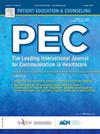美国聋人手语使用者健康素养的预测因素
IF 3.1
2区 医学
Q2 PUBLIC, ENVIRONMENTAL & OCCUPATIONAL HEALTH
引用次数: 0
摘要
目的健康素养是个体健康、医疗依从性和健康相关决策的重要预测指标。本研究探讨美国聋人手语使用者健康素养的预测因素。方法对408名美国手语失聪使用者和445名英语听力者进行最新生命体征测试,这是一种英语和美国手语健康素养的测量方法,同时对语言能力和阅读技能进行评估。结果:与听力正常的参与者相比,聋人健康素养不足的几率要高出3.7倍(95 % CI: 2.7, 4.9)。二元logistic回归显示,聋人被试的美国手语熟练程度和英语阅读等级等效解释了健康素养方差的34.2% % (Nagelkerke R2), χ2(2) = 101.520,p <; .001。相比之下,在听力参与者中,英语熟练程度和英语阅读等级等同解释了47.8 %的健康素养方差,χ2(2) = 171.071,p <; .001。聋人在为自己和他人寻找、理解和使用与健康相关的决策和行动的信息和服务方面存在更大的困难。实践意义卫生专业人员和卫生系统应分配资源,以减轻聋人的健康素养障碍,并使更多的健康信息在美国手语中可用。本文章由计算机程序翻译,如有差异,请以英文原文为准。
Predictors of health literacy among Deaf American Sign Language users
Objective
Health literacy is an important predictor of individuals’ health, medical adherence, and health-related decision making. This study investigated the predictors of health literacy among Deaf American Sign Language (ASL) users.
Methods
408 Deaf ASL users and 445 Hearing English speakers were administered the Newest Vital Sign, a measure of health literacy available in both English and ASL, along with assessments of language proficiency and reading skills.
Results
Deaf participants had 3.7 times greater odds of inadequate health literacy (95 % CI: 2.7, 4.9) compared to their hearing counterparts. Binary logistic regression revealed that Deaf participants’ ASL proficiency and English reading grade equivalent explained 34.2 % (Nagelkerke R2) of the variance in health literacy, χ2(2) = 101.520, p < .001. Among hearing participants, by contrast, English proficiency and English reading grade equivalent explained 47.8 % of the variance in health literacy, χ2(2) = 171.071, p < .001.
Conclusions
Deaf people are at risk for having greater difficulty to find, understand, and use information and services to inform health-related decisions and actions for themselves and others.
Practice implications
Health professionals and health systems should allocate resources to mitigate health literacy barriers among Deaf people and make health information more available in ASL.
求助全文
通过发布文献求助,成功后即可免费获取论文全文。
去求助
来源期刊

Patient Education and Counseling
医学-公共卫生、环境卫生与职业卫生
CiteScore
5.60
自引率
11.40%
发文量
384
审稿时长
46 days
期刊介绍:
Patient Education and Counseling is an interdisciplinary, international journal for patient education and health promotion researchers, managers and clinicians. The journal seeks to explore and elucidate the educational, counseling and communication models in health care. Its aim is to provide a forum for fundamental as well as applied research, and to promote the study of organizational issues involved with the delivery of patient education, counseling, health promotion services and training models in improving communication between providers and patients.
 求助内容:
求助内容: 应助结果提醒方式:
应助结果提醒方式:


